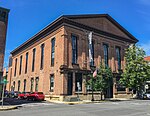Basilica Hudson

Basilica Hudson is an arts and performance venue in Hudson, New York, US. It was established in 2010 out of a 19th-century factory located near the city's "South Bay" riverfront along the Hudson River. Basilica Hudson schedules its programming between spring and fall. Events range from film screenings and visual art exhibitions, to annual farmers' and flea markets with local vendors. It is the setting for the annual Basilica SoundScape festival and the 24 Hour Drone music festival, Its creative directors in 2013 are musician Melissa Auf der Maur and independent filmmaker Tony Stone. In 2012, The Guardian named Basilica Hudson one of the ten best industrial-chic spaces worldwide.
Excerpt from the Wikipedia article Basilica Hudson (License: CC BY-SA 3.0, Authors, Images).Basilica Hudson
Front Street,
Geographical coordinates (GPS) Address Website External links Nearby Places Show on map
Geographical coordinates (GPS)
| Latitude | Longitude |
|---|---|
| N 42.25188889 ° | E -73.79861111 ° |
Address
Basilica Hudson
Front Street 110
12534
New York, United States
Open on Google Maps







